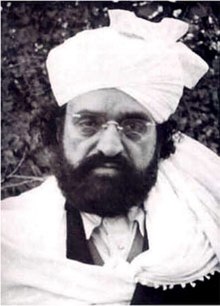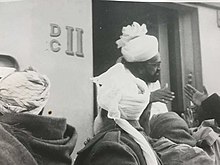This article has multiple issues. Please help improve it or discuss these issues on the talk page. (Learn how and when to remove these messages)
|
| Ghulam Mohiyuddin Gilani | |
|---|---|
| غلام محی الدین گیلانی | |
 | |
| Title | Pir, Syed |
| Personal life | |
| Born | (1891-12-00)December 1891 Golra Sharif, British India (present-day Pakistan) |
| Died | 22 June 1974 (aged 83) Golra Sharif, Pakistan |
| Children | Syed Ghulam Moinuddin Gilani Syed Shah Abdul Haq Gilani |
| Parent | Meher Ali Shah |
| Other names | Babuji |
| Religious life | |
| Religion | Islam |
| Order | Sufism Qadiriyya Chishti Order |
| Muslim leader | |
| Based in | Golra Sharif |
| Predecessor | Meher Ali Shah |
| Part of a series on Islam Sufism |
|---|
 |
| Ideas |
| Practices |
Sufi orders
|
| List of sufis |
| Topics in Sufism |
|
|
Peer Syed Ghulam Mohiyuddin Gilani (December 1891 - 22 June 1974), commonly called Babuji, was a Sufi scholar from Golra Sharif, Pakistan, belonging to the Chishti order. He was the son of Peer Meher Ali Shah and served as the sajjada nashin of the Golra Sharif shrine from 1937 to 1974.
Education

He received his early education from Qari Abdul Rahman of Jawnpur and Maulana Muhammad Ghazi under the supervision of his father Peer Meher Ali Shah.
After completing his education, Ghulam Mohiyuddin received the caliphate (khilafat) from his father but was not prepared to take anyone as his murid (spiritual disciple) mainly due to his claim that he did not possess the merit that is required for extending bay'ah to others. Only after his father Meher Ali Shah assured that, “I agree to be responsible for anyone who takes bai'at at your hand.”, he started taking people as his murid.
Beliefs

Following the example of his father, Ghulam Mohiyuddin was a firm adherent to the concept of Ibn Arabi's ideology of "Wahdat-ul-Wajood" (Ultimate Unity of Being). According to him, the Divine Will is at work behind all that is happening in the universe. The Divine Will which is absolute and everlasting manifests itself in the diverse aspects of this universe.
Ghulam Mohiyuddin was also a firm admirer of Jalāl ad-Dīn Muhammad Rūmī so much so that he is reported to have made his qawwal i.e; the person who performs Qawwali, memorize almost half of the Masnavi which was then performed at the shrine. His biography states that he would sometimes refer to Rumi as “Pir-e-Ma” (mine guide).

Political activity
Ghulam Mohiyuddin supported the Pakistan Movement, encouraging the mass displacement of the population around the time of the Partition of India.
Death

Ghulam Mohiyuddin died on 22 June 1974 after prolonged illness and was buried next to his father in Golra Sharif.
References
- ^ Bennett, Clinton; Ramsey, Charles M (1 March 2012). South Asian Sufis: Devotion, Deviation, and Destiny. ISBN 9781441135896. Retrieved 30 August 2018.
- Imran Ali Teepu (15 February 2009). "Pir Naseeruddin laid to rest". Dawn. Retrieved 30 August 2018.
- Aamir Yasin (4 June 2018). "Central Jamia Masjid — a 115-year-old symbol of Muslim unity". Dawn. Retrieved 2 June 2019.
- Maulana Faiz Ahmad Faiz. Mehr-e-Munir. p. 368.
- Fadil Khan, Dr Muhammad (1998). Mihr-e-munīr: Biography of Ḥaḍrat Syed Pīr Meher Alī Shāh (in English) (1 ed.). Pakistan International Printers. pp. 329–330.
- "Wahdat ul Wajood". www.thelightofgolrasharif.com.
- Nasir Amir, Farzana Arshad, Abdul Qadir Mushtaq, Rizwan Akhtar (December 2019). "Sacred status of Qawali in Chishtiyya order: A case study of the Shrine of Meher Ali Shah" (PDF). Journal of the Research Society of Pakistan. 56 (2): 277.
{{cite journal}}: CS1 maint: multiple names: authors list (link) - Ismail Sethi, Prof. M. (1994). The Living Truth - Hadrat Babuji (First ed.). Lahore, Pakistan: The Kissan Art Press - 10 Durand Road Lahore.
- "Babuji (R.A) as a traveller (Konya- Babuji and Mevlana Rumi)". The Light of Golra Sharif.
- "Role in Pakistan movement". www.thelightofgolrasharif.com. Retrieved 2 June 2019.